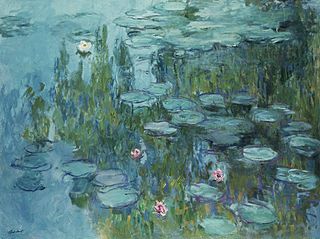
Cyan is the color between blue and green on the visible spectrum of light. It is evoked by light with a predominant wavelength between 500 and 520 nm, between the wavelengths of green and blue.

The CMYK color model is a subtractive color model, based on the CMY color model, used in color printing, and is also used to describe the printing process itself. The abbreviation CMYK refers to the four ink plates used: cyan, magenta, yellow, and key.

Magenta is a purplish-red color. On color wheels of the RGB (additive) and CMY (subtractive) color models, it is located precisely midway between blue and red. It is one of the four colors of ink used in color printing by an inkjet printer, along with yellow, cyan, and black to make all the other colors. The tone of magenta used in printing, printer's magenta, is redder than the magenta of the RGB (additive) model, the former being closer to rose.

Laser printing is an electrostatic digital printing process. It produces high-quality text and graphics by repeatedly passing a laser beam back and forth over a negatively charged cylinder called a "drum" to define a differentially charged image. The drum then selectively collects electrically charged powdered ink (toner), and transfers the image to paper, which is then heated to permanently fuse the text, imagery, or both to the paper. As with digital photocopiers, laser printers employ a xerographic printing process. Laser printing differs from traditional xerography as implemented in analog photocopiers in that in the latter, the image is formed by reflecting light off an existing document onto the exposed drum.

Inkjet printing is a type of computer printing that recreates a digital image by propelling droplets of ink onto paper and plastic substrates. Inkjet printers were the most commonly used type of printer in 2008, and range from small inexpensive consumer models to expensive professional machines. By 2019, laser printers outsold inkjet printers by nearly a 2:1 ratio, 9.6% vs 5.1% of all computer peripherals.
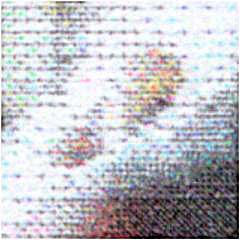
Dots per inch is a measure of spatial printing, video or image scanner dot density, in particular the number of individual dots that can be placed in a line within the span of 1 inch (2.54 cm). Similarly, dots per centimetre refers to the number of individual dots that can be placed within a line of 1 centimetre (0.394 in).

In color reproduction and colorimetry, a gamut, or color gamut, is a convex set containing the colors that can be accurately represented, i.e. reproduced by an output device or measured by an input device. Devices with a larger gamut can represent more colors. Similarly, gamut may also refer to the colors within a defined color space, which is not linked to a specific device. A trichromatic gamut is often visualized as a color triangle. A less common usage defines gamut as the subset of colors contained within an image, scene or video.

Giclée describes digital prints intended as fine art and produced by inkjet printers. The term is a neologism, ultimately derived from the French word gicleur, coined in 1991 by printmaker Jack Duganne. The name was originally applied to fine art prints created on a modified Iris printer in a process invented in the late 1980s. It has since been used widely to mean any fine-art printing, usually archival, printed by inkjet. It is often used by artists, galleries, and print shops for their high quality printing, but is also used generically for art printing of any quality.
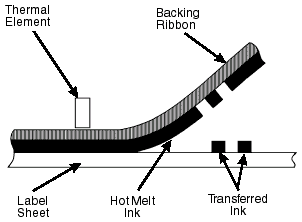
Thermal-transfer printing is a digital printing method in which material is applied to paper by melting a coating of ribbon so that it stays glued to the material on which the print is applied. It contrasts with direct thermal printing, where no ribbon is present in the process.
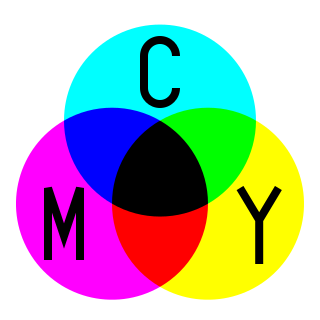
Subtractive color or subtractive color mixing predicts the spectral power distribution of light after it passes through successive layers of partially absorbing media. This idealized model is the essential principle of how dyes and pigments are used in color printing and photography, where the perception of color is elicited after white light passes through microscopic "stacks" of partially absorbing media allowing some wavelengths of light to reach the eye and not others, and also in painting, whether the colors are mixed or applied in successive layers.
Digital printing is a method of printing from a digital-based image directly to a variety of media. It usually refers to professional printing where small-run jobs from desktop publishing and other digital sources are printed using large-format and/or high-volume laser or inkjet printers.
Color printing or colour printing is the reproduction of an image or text in color.

MicroDry is a computer printing system developed by the ALPS corporation of Japan. It is a wax/resin-transfer system using individual colored thermal ribbon cartridges, and can print in process color using cyan, magenta, yellow, and black cartridges, as well as spot-color cartridges as white, metallic silver, and metallic gold, on a wide variety of paper and transparency stock. Certain MicroDry printers can also operate in dye sublimation mode, using special cartridges and paper. ALPS licensed the technology to Citizen and to Okidata. Alps also produced the actual printer hardware and ink ribbon cartridges for those companies.
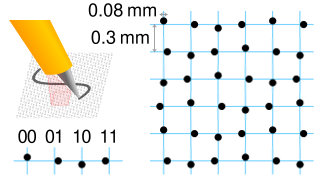
Digital paper, also known as interactive paper, is patterned paper used in conjunction with a digital pen to create handwritten digital documents. The printed dot pattern identifies the position coordinates on the paper. The digital pen uses this pattern to store handwriting and upload it to a computer.
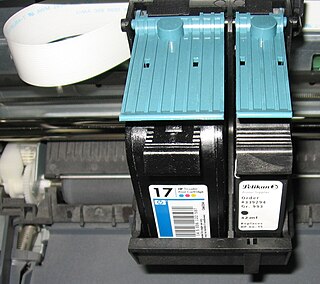
An ink cartridge or inkjet cartridge is a component of an inkjet printer that contains ink to be deposited onto paper during printing. It consists of one or more ink reservoirs and can include electronic contacts and a chip to exchange information with the printer.
There are three types of color mixing models, depending on the relative brightness of the resultant mixture: additive, subtractive, and average. In these models, mixing black and white will yield white, black and gray, respectively. Physical mixing processes, e.g. mixing light beams or oil paints, will follow one or a hybrid of these 3 models. Each mixing model is associated with several color models, depending on the approximate primary colors used. The most common color models are optimized to human trichromatic color vision, therefore comprising three primary colors.

The color magenta has notable tints and shades. These various colors are shown below.
A contract proof usually serves as an agreement between customer and printer and as a color reference guide for adjusting the press before the final press run. Most contract proofs are a prepress proof.
The G7 Method is a printing procedure used for visually accurate color reproduction by putting emphasis on matching grayscale colorimetric measurements between processes. G7 stands for grayscale plus seven colors: the subtractive colors typically used in printing and the additive colors. The method is used in many applications of printing such as offset lithography, flexography, and gravure since it uses a one-dimensional neutral print density curve (NPDC) to match neutral tonality between two G7 calibrated printing systems. The G7 method is not a completely accurate color management system nor is it officially standardized by the International Color Consortium (ICC).
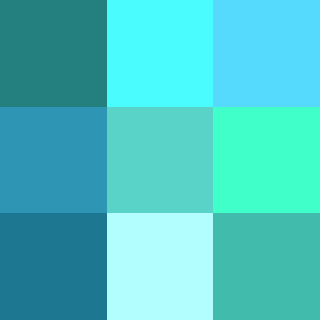
The color cyan, a greenish-blue, has notable tints and shades. It is one of the subtractive primary colors along with magenta, and yellow.












